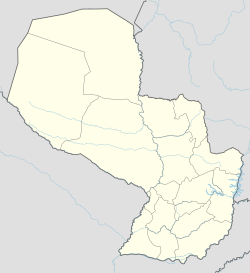This article needs additional citations for verification. (May 2023) |
San Pedro de Ycuamandyyú (Spanish pronunciation: [ˈsam ˈpeðɾo ðejkwamandiˈʝu]) is a city and district in Paraguay. It is the capital of the department of San Pedro.
San Pedro de Ycuamandyyú | |
|---|---|
City and district | |
 | |
| Coordinates: 24°6′S 57°5′W / 24.100°S 57.083°W | |
| Country | Paraguay |
| Department | San Pedro |
| Founded | 16 March 1786 by Commander José Ferreira and Captain Pedro García |
| Government | |
| • Intendente municipal | Carlos Alberto Quiñónez(ANR) |
| Area | |
| • Total | 3,185 km2 (1,230 sq mi) |
| Elevation | 64 m (210 ft) |
| Population (2008) | |
| • Total | 32,918 |
| • Density | 9/km2 (20/sq mi) |
| Time zone | -4 Gmt |
| Postal code | 8000 |
| Area code | (595) (342) |
The conquistador Aleixo Garcia, the first European to cross Paraguay and reach the Inca empire in 1524, is believed to have been killed near San Pedro on his return.
Etymology
editOriginally the name was "Villa de San Pedro Apóstol de ykuaminday", San Pedro's village from the water source of the cotton field, is the translation of the words in Guaraní Language "ykua" water source and "mandyju" cotton, there was a cotton plant in a well. Mr. Pedro García Lacoizqueta was sent by Governor Pedro Melo de Portugal to establish a small village in that place.
Geography
editRoute XI "Juana de Lara" links the city to Route III "Elizardo Aquino" to the east. It is 25 km (16 mi) far from Paraguay River, 15 km (9 mi) from Antequera district and 3 km (2 mi) from Jejui River.
Weather
editThe weather is humid and rainy, humidity ranges from 70 to 80%. The average temperature 23 °C, the maximum in summer is 35 °C and the minimum 10 °C.
| Climate data for San Pedro de Ycuamandiyú (1991–2020) | |||||||||||||
|---|---|---|---|---|---|---|---|---|---|---|---|---|---|
| Month | Jan | Feb | Mar | Apr | May | Jun | Jul | Aug | Sep | Oct | Nov | Dec | Year |
| Mean daily maximum °C (°F) | 34.2 (93.6) |
33.2 (91.8) |
31.9 (89.4) |
29.0 (84.2) |
24.9 (76.8) |
23.5 (74.3) |
23.8 (74.8) |
26.7 (80.1) |
28.7 (83.7) |
31.0 (87.8) |
31.8 (89.2) |
33.3 (91.9) |
29.3 (84.7) |
| Daily mean °C (°F) | 27.2 (81.0) |
26.7 (80.1) |
25.5 (77.9) |
23.2 (73.8) |
19.5 (67.1) |
18.5 (65.3) |
17.5 (63.5) |
19.5 (67.1) |
21.4 (70.5) |
24.2 (75.6) |
25.0 (77.0) |
26.7 (80.1) |
22.9 (73.2) |
| Mean daily minimum °C (°F) | 22.7 (72.9) |
22.3 (72.1) |
21.1 (70.0) |
18.7 (65.7) |
15.3 (59.5) |
14.2 (57.6) |
12.7 (54.9) |
14.1 (57.4) |
16.2 (61.2) |
19.5 (67.1) |
20.1 (68.2) |
21.9 (71.4) |
18.2 (64.8) |
| Average precipitation mm (inches) | 139.7 (5.50) |
179.4 (7.06) |
100.3 (3.95) |
153.1 (6.03) |
140.2 (5.52) |
81.6 (3.21) |
58.5 (2.30) |
39.2 (1.54) |
88.3 (3.48) |
164.5 (6.48) |
187.9 (7.40) |
161.9 (6.37) |
1,494.6 (58.84) |
| Source: NOAA[1] | |||||||||||||
Demography
editSan Pedro's population is 29,097 inhabitants, 15,043 are men and 14,054 women. In the urban area 7,927 people and the rural area, 21,170 people.
History
editIn 1525, native people might have killed the Portuguese Alejo García, who was the first European to explore Paraguay by walking the whole Chaco Paraguayo. He also went through the Tapé Avirú.
San Pedro was founded on 16 March 1786 by Commander José Ferreira and Captain Pedro García.
Economy
editThe city economy is based mainly on cattle rising. Farming includes yerba mate, cotton, soy, bean, potato, alfalfa, citrus fruits, maní, manioc and wheat. Industries like wood, oil and petit grain. Craftmanship like embroidering ao poi and handed-works on clay.
Tourism
editSan Pedro is the "Capital of Cordiality", because of the hospitality of its people. The most beautiful things are the ancient and colorful houses from the colonial period which can be appreciated in the city.
The church was built during Don Carlos Antonio López government and rebuilt with all the characteristics of that period. The altarpiece and the images are invaluable parts of the Paraguayan History. Some important historical elements of the region can be seen at Mr. Francisco Resquin's museum.
Casa de la Cultura is another interesting place because artists present their works there, poems, guitar and music courses are held in this house. Jejui River offers its shores and beach for people where they can go camping.
Bibliography and references
edit- Geografía Ilustrada del Paraguay, Distribuidora Arami SRL; 2007. ISBN 99925-68-04-6
- Geografía del Paraguay, Primera Edición 1999, Editorial Hispana Paraguay SRL,
References
edit- ^ "World Meteorological Organization Climate Normals for 1991-2020 — San Pedro de Ycuamandiyú". National Oceanic and Atmospheric Administration. Retrieved January 26, 2024.

